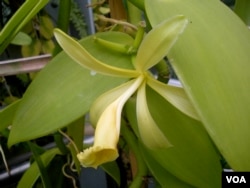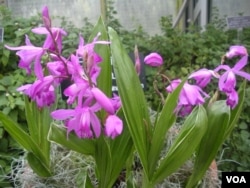A new exhibit at the U.S. Botanic Garden in Washington features a vibrant collection of orchids from all over the world. This elegant flower is not solely ornamental, its uses also extend to medicine and cooking.
Sensory celebration
To walk into the U.S. Botanic Garden in Washington is to encounter a feast for the senses.
Johann Strauss’s classic Blue Danube waltz fills the air as does the sweet aroma of hundreds of fragrant orchids. This sensory orchestra is part of a new exhibit fittingly called "Orchid Symphony," an annual collaboration with Smithsonian Gardens.
The garden chose Orchid Symphony as a theme so it could display a wide variety of orchids, while the symphony “suggested a feeling of elegance and grandeur that we thought was fitting with orchids and also the architecture of our conservatory,” said Nick Nelson, the landscape architect at the U.S. Botanic Garden. “We have fountains that we have computer programmed and synchronized with classical music [and] a lovely elegant orchid chandelier in the center of the garden."
In keeping with the musical theme, there are also topiaries in the shape of a violin, a cello and other musical instruments “to add a bit of whimsy to the garden,” he said.
Nelson added that while the garden has a permanent orchid room within the conservatory, this time of year they have thousands of orchids coming into bloom, which provides a great opportunity to get the message of orchids across to the public.
Orchid varieties
Orchids are found in almost every eco-system in the world.
Jungle orchids thrive in various tropical climates and there are desert orchids blooming in arid environments, according to the garden's deputy executive director Ari Novy.
“The orchids that you’re likely to find growing either in a greenhouse such as this, or that you can buy at a garden center, are probably what we call epiphytic or tropical orchids, meaning they are orchids that in nature are found growing on other plants, especially forest trees,” he said. "But there are many other kinds of orchids as well.”
He pointed to a flower that he identified as a Mexipedium orchid.
“It’s an orchid found in Mexico, that loves growing on rocks,” he said. “It’s therefore called a lithophyte, meaning a plant that grows on rocks.”
Just like a cactus or any other desert-adapted plant, this orchid can store moisture so that it can handle the long periods of drought in the arid environment.
Medicinal and dessert orchids
Novy also pointed to a batch of lovely purple flowers with elongated green leaves called Bletilla Striata, or the Chinese Ground Orchid.
“Not only is it sold because it’s so beautiful,” he said, “but it’s also used in traditional Chinese medicine where it’s ground up into a powder and used to stop excessive bleeding.”
In addition to using orchids for medicinal purposes, many cultures eat them in food products, often unknowingly.
The most famous edible orchid is the vanilla, said Novy. “Vanilla is a vine-form orchid that’s native to Central and South America, although vanilla production today is most famous in Madagascar.”
Madagascar is the largest producer of vanilla beans, but since the island lacks the plant's pollinating bee species, the flowers must be hand-pollinated.
First Lady orchids
Orchids, as with roses, are often created to honor someone famous. A large painting of a Cattleya ‘Michelle Obama’ orchid, by orchid artist Patricia Laspino, is on display in the entry foyer of the Garden. It is the latest in a line of First Lady orchids that began in 1929 with the pink bloom named for Lou Henry Hoover, wife of Herbert Hoover.
Ari Novy says, as a plant scientist, orchids occupy a very special place in his heart. “Orchids are absolutely gorgeous. They capture our imaginations. They showcase all of the colors of the rainbow in a way that’s just wonderful for us to see.”
“And so at the end of the day," he said, "what we’re trying to do here at the United States Botanic Garden is we’re trying to educate. But we know that we can educate best if we first put a smile on your face.”
Sensory celebration
To walk into the U.S. Botanic Garden in Washington is to encounter a feast for the senses.
Johann Strauss’s classic Blue Danube waltz fills the air as does the sweet aroma of hundreds of fragrant orchids. This sensory orchestra is part of a new exhibit fittingly called "Orchid Symphony," an annual collaboration with Smithsonian Gardens.
The garden chose Orchid Symphony as a theme so it could display a wide variety of orchids, while the symphony “suggested a feeling of elegance and grandeur that we thought was fitting with orchids and also the architecture of our conservatory,” said Nick Nelson, the landscape architect at the U.S. Botanic Garden. “We have fountains that we have computer programmed and synchronized with classical music [and] a lovely elegant orchid chandelier in the center of the garden."
In keeping with the musical theme, there are also topiaries in the shape of a violin, a cello and other musical instruments “to add a bit of whimsy to the garden,” he said.
Nelson added that while the garden has a permanent orchid room within the conservatory, this time of year they have thousands of orchids coming into bloom, which provides a great opportunity to get the message of orchids across to the public.
Orchid varieties
Orchids are found in almost every eco-system in the world.
Jungle orchids thrive in various tropical climates and there are desert orchids blooming in arid environments, according to the garden's deputy executive director Ari Novy.
“The orchids that you’re likely to find growing either in a greenhouse such as this, or that you can buy at a garden center, are probably what we call epiphytic or tropical orchids, meaning they are orchids that in nature are found growing on other plants, especially forest trees,” he said. "But there are many other kinds of orchids as well.”
He pointed to a flower that he identified as a Mexipedium orchid.
“It’s an orchid found in Mexico, that loves growing on rocks,” he said. “It’s therefore called a lithophyte, meaning a plant that grows on rocks.”
Just like a cactus or any other desert-adapted plant, this orchid can store moisture so that it can handle the long periods of drought in the arid environment.
Medicinal and dessert orchids
Novy also pointed to a batch of lovely purple flowers with elongated green leaves called Bletilla Striata, or the Chinese Ground Orchid.
“Not only is it sold because it’s so beautiful,” he said, “but it’s also used in traditional Chinese medicine where it’s ground up into a powder and used to stop excessive bleeding.”
In addition to using orchids for medicinal purposes, many cultures eat them in food products, often unknowingly.
The most famous edible orchid is the vanilla, said Novy. “Vanilla is a vine-form orchid that’s native to Central and South America, although vanilla production today is most famous in Madagascar.”
Madagascar is the largest producer of vanilla beans, but since the island lacks the plant's pollinating bee species, the flowers must be hand-pollinated.
First Lady orchids
Orchids, as with roses, are often created to honor someone famous. A large painting of a Cattleya ‘Michelle Obama’ orchid, by orchid artist Patricia Laspino, is on display in the entry foyer of the Garden. It is the latest in a line of First Lady orchids that began in 1929 with the pink bloom named for Lou Henry Hoover, wife of Herbert Hoover.
Ari Novy says, as a plant scientist, orchids occupy a very special place in his heart. “Orchids are absolutely gorgeous. They capture our imaginations. They showcase all of the colors of the rainbow in a way that’s just wonderful for us to see.”
“And so at the end of the day," he said, "what we’re trying to do here at the United States Botanic Garden is we’re trying to educate. But we know that we can educate best if we first put a smile on your face.”









